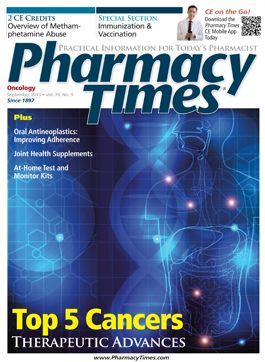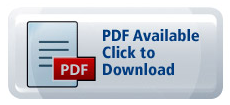Publication
Article
Pharmacy Times
A Therapeutic Option for the Management of Type 2 Diabetes
This article was sponsored by Janssen Pharmaceuticals, Inc.
Type 2 diabetes mellitus (T2DM), which accounts for 90% to 95% of all cases of diabetes in adults, is a disorder that is characterized by hyperglycemia.1,2
In addition to insulin resistance and beta cell dysfunction, perturbations in the brain, adipose tissue, and kidneys contribute to the hyperglycemia characteristic of T2DM.3
The kidney plays a key role in glucose homeostasis by regulating the reabsorption of glucose following plasma filtration.4
Sodium-glucose co-transporters (SGLTs: SGLT1 and SGLT2) are responsible for glucose
reabsorption
in the kidney.5
To inform pharmacists about an option for the management of T2DM with a novel mechanism of action,
Pharmacy Times
has made available an Information for the Pharmacist article that highlights INVOKANATM
(canagliflozin),
an SGLT2 inhibitor indicated as an adjunct to diet and exercise to improve glycemic control in adults with T2DM. INVOKANATM
is not recommended in patients with [per Indication] type 1 diabetes or diabetic ketoacidosis.6
IMPORTANT SAFETY INFORMATION
CONTRAINDICATIONS
- History of a serious hypersensitivity reaction to INVOKANA™.
- Severe renal impairment (eGFR <30 mL/min/1.73 m2), end stage renal disease, or patients on dialysis.
WARNINGS and PRECAUTIONS
- Hypotension: INVOKANA™ causes intravascular volume contraction. Symptomatic hypotension can occur after initiating INVOKANA™, particularly in patients with impaired renal function (eGFR <60 mL/min/1.73 m2), elderly patients, and patients on either diuretics or medications that interfere with the renin-angiotensin-aldosterone system (eg, angiotensin-converting-enzyme [ACE] inhibitors, angiotensin receptor blockers [ARBs]), or patients with low systolic blood pressure. Before initiating INVOKANA™ in patients with one or more of these characteristics, volume status should be assessed and corrected. Monitor for signs and symptoms after initiating therapy.
- Impairment in Renal Function: INVOKANA™ increases serum creatinine and decreases eGFR. Patients with hypovolemia may be more susceptible to these changes. Renal function abnormalities can occur after initiating INVOKANA™. More frequent renal function monitoring is recommended in patients with an eGFR below 60 mL/min/1.73 m2.
- Hyperkalemia: INVOKANA™ can lead to hyperkalemia. Patients with moderate renal impairment who are taking medications that interfere with potassium excretion, such as potassium-sparing diuretics, or medications that interfere with the renin-angiotensin-aldosterone system are more likely to develop hyperkalemia. Monitor serum potassium levels periodically after initiating INVOKANA™ in patients with impaired renal function and in patients predisposed to hyperkalemia due to medications or other medical conditions.
- Hypoglycemia With Concomitant Use With Insulin and Insulin Secretagogues: Insulin and insulin secretagogues are known to cause hypoglycemia. INVOKANA™ can increase the risk of hypoglycemia when combined with insulin or an insulin secretagogue. Therefore, a lower dose of insulin or insulin secretagogue may be required to minimize the risk of hypoglycemia when used in combination with INVOKANA™.
- Genital Mycotic Infections: INVOKANA™ increases the risk of genital mycotic infections. Patients with a history of genital mycotic infections and uncircumcised males were more likely to develop genital mycotic infections. Monitor and treat appropriately.
- Hypersensitivity Reactions: Hypersensitivity reactions (eg, generalized urticaria), some serious, were reported with INVOKANA™ treatment; these reactions generally occurred within hours to days after initiating INVOKANA™. If hypersensitivity reactions occur, discontinue use of INVOKANA™; treat per standard of care and monitor until signs and symptoms resolve.
- Increases in Low-Density Lipoprotein (LDL-C): Dose-related increases in LDL-C occur with INVOKANA™. Monitor LDL-C and treat per standard of care after initiating INVOKANA™.
- Macrovascular Outcomes: There have been no clinical studies establishing conclusive evidence of macrovascular risk reduction with INVOKANA™ or any other antidiabetic drug.
DRUG INTERACTIONS
- UGT Enzyme Inducers: Rifampin: Co-administration of canagliflozin with rifampin, a nonselective inducer of several UGT enzymes, including UGT1A9, UGT2B4, decreased canagliflozin area under the curve (AUC) by 51%. This decrease in exposure to canagliflozin may decrease efficacy. If an inducer of these UGTs (eg, rifampin, phenytoin, phenobarbital, ritonavir) must be co-administered with INVOKANA™ (canagliflozin), consider increasing the dose to 300 mg once daily if patients are currently tolerating INVOKANA™ 100 mg once daily, have an eGFR greater than 60mL/min/1.73 m2, and require additional glycemic control. Consider other antihyperglycemic therapy in patients with an eGFR of 45 to less than 60 mL/min/1.73 m2 receiving concurrent therapy with a UGT inducer and requiring additional glycemic control.
- Digoxin: There was an increase in the area AUC and mean peak drug concentration (Cmax) of digoxin (20% and 36%, respectively) when co-administered with INVOKANA™ 300 mg. Patients taking INVOKANA™ with concomitant digoxin should be monitored appropriately.
USE IN SPECIFIC POPULATIONS
- Pregnancy Category C: There are no adequate and well-controlled studies of INVOKANA™ in pregnant women. Based on results from rat studies, canagliflozin may affect renal development and maturation. In a juvenile rat study, increased kidney weights and renal pelvic and tubular dilatation were evident at ≥0.5 times clinical exposure from a 300-mg dose.
These outcomes occurred with drug exposure during periods of animal development that correspond to the late second and third trimester of human development. During pregnancy, consider appropriate alternative therapies, especially during the second and third trimesters. INVOKANA™ should be used during pregnancy only if the potential benefit justifies the potential risk to the fetus.
- Nursing Mothers: It is not known if INVOKANA™ is excreted in human milk. INVOKANA™ is secreted in the milk of lactating rats, reaching levels 1.4 times higher than that in maternal plasma. Data in juvenile rats directly exposed to INVOKANA™ showed risk to the developing kidney (renal pelvic and tubular dilatations) during maturation. Since human kidney maturation occurs in utero and during the first 2 years of life when lactational exposure may occur, there may be risk to the developing human kidney. Because many drugs are excreted in human milk, and because of the potential for serious adverse reactions in nursing infants from INVOKANA™, a decision should be made whether to discontinue nursing or to discontinue INVOKANA™, taking into account the importance of the drug to the mother.
- Pediatric Use: Safety and effectiveness of INVOKANA™ in pediatric patients under 18 years of age have not been established.
- Geriatric Use: Two thousand thirty-four (2034) patients 65 years and older, and 345 patients 75 years and older were exposed to INVOKANA™ in nine clinical studies of INVOKANA™. Patients 65 years and older had a higher incidence of adverse reactions related to reduced intravascular volume with INVOKANA™ (such as hypotension, postural dizziness, orthostatic hypotension, syncope, and dehydration), particularly with the 300-mg daily dose, compared to younger patients; more prominent increase in the incidence was seen in patients who were ≥75 years of age. Smaller reductions in HbA1C with INVOKANA™ relative to placebo were seen in older (65 years and older; -0.61% with INVOKANA™ 100 mg and -0.74% with INVOKANA™ 300 mg relative to placebo) compared to younger patients (-0.72% with INVOKANA™ 100 mg and -0.87% with INVOKANA™ 300 mg relative to placebo).
- Renal Impairment: The efficacy and safety of INVOKANA™ were evaluated in a study that included patients with moderate renal impairment (eGFR 30 to < 50 mL/min/1.73 m2). These patients had less overall glycemic efficacy and had a higher occurrence of adverse reactions related to reduced intravascular volume, renal-related adverse reactions, and decreases in eGFR compared to patients with mild renal impairment or normal renal function (eGFR ≥ 60 mL/min/1.73 m2); patients treated with INVOKANA™ 300 mg were more likely to experience increases in potassium.
The efficacy and safety of INVOKANA™ have not been established in patients with severe renal impairment (eGFR < 30 mL/min/ 1.73 m2), with end-stage renal disease (ESRD), or receiving dialysis. INVOKANA™ is not expected to be effective in these patient populations.
- Hepatic Impairment: No dosage adjustment is necessary in patients with mild or moderate hepatic impairment. The use of INVOKANA™ has not been studied in patients with severe hepatic impairment and it is therefore not recommended.
OVERDOSAGE
- There were no reports of overdose during the clinical development program of INVOKANA™ (canagliflozin).
In the event of an overdose, contact the Poison Control Center. It is also reasonable to employ the usual supportive measures, eg, remove unabsorbed material from the gastrointestinal tract, employ clinical monitoring, and institute supportive treatment as dictated by the patient’s clinical status. Canagliflozin was negligibly removed during a 4-hour hemodialysis session. Canagliflozin is not expected to be dialyzable by peritoneal dialysis.
ADVERSE REACTIONS
- The most common (≥5%) adverse reactions were female genital mycotic infections, urinary tract infections, and increased urination. Adverse reactions in ≥2% of patients were male genital mycotic infections, vulvovaginal pruritus, thirst, nausea, and constipation.
K02CAN13149 Please see full Prescribing Information and Medication Guide.
References
- Centers for Disease Control and Prevention. National diabetes fact sheet, 2011. www.cdc.gov/diabetes/pubs/pdf/ndfs_2011.pdf . Accessed May 3, 2013.
- American Diabetes Association. Diagnosis and classification of diabetes mellitus. Diabetes Care. 2013;36(suppl 1):S67-S74.
- DeFronzo RA. Banting lecture. From the triumvirate to the ominous octet: a new paradigm for the treatment of type 2 diabetes mellitus. Diabetes. 2009;58(4):773-795.
- Neumiller JJ, White JR Jr, Campbell RK. Sodium-glucose co-transport inhibitors: progress and therapeutic potential in type 2 diabetes mellitus. Drugs. 2010;70(4):377-385.
- Jabbour SA, Goldstein BJ. Sodium glucose co-transporter 2 inhibitors: blocking renal tubular reabsorption of glucose to improve glycaemic control in patients with diabetes. Int J Clin Pract. 2008;62(8):1279-1284.
- INVOKANA™ [prescribing information]. Titusville, NJ: Janssen Pharmaceuticals, Inc.; March 2013.
Canagliflozin is licensed from Mitsubishi Tanabe Pharma Corporation.
K02CANAP13033H








